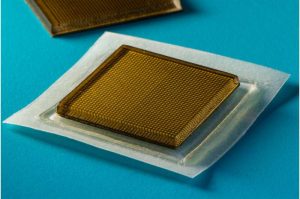1. One thing that helps

MIT engineers have developed an ultrasound machine that’s as wearable and accessible as a band-aid. No hospital is complete without an ultrasound machine. They provide doctors a safe and easy way to see live images from inside your body. But they are expensive and bulky – until now.
The engineers have managed to shrink the transducer – responsible for emitting ultrasound waves – to the size of a stamp. A special adhesive layer made from hydrogel is used to attach the transducer to the skin. Unlike normal gels, this hydrogel is elastic, stretchy and does not dry out on the skin. This allows the ultrasound sticker to fit comfortably and stick to the skin for 48 hours even when the patient is moving around. Images taken using the small device are clearer than previous attempts with other forms of portable ultrasound imaging.
The next stage is a real game-changer. They are looking to make the device operate wirelessly and be able to pair with your smartphone, to allow doctors (and you!) to see live images of organs and muscles when you are not tethered to an ultrasound machine. For people who complain of muscle issues after workouts, lead co-author Chen says, “With imaging, we might be able to capture the moment in a workout before overuse, and stop before muscles become sore.” As someone who is sitting with sore muscles this morning, that sounds very appealing.
2. One to be wary of
AI scanning is being used in the US to address the issue of gun control in schools. Media headlines about shooting incidents terrify every parent and this has resulted in many suggestions on how to prevent guns being brought to school. Using AI to scan students entering the campus is one that is getting more prevalent. However, public documents reveal that such systems fail to deliver on their promise of frictionless school security.
Just like old-fashioned metal detectors, AI scanners also have sensitivity adjustments. Higher sensitivity means more detections and more false alarms. Lower sensitivity means they don’t trigger unnecessarily but may miss things. Finding the right sensitivity levels has been one of the major issues with such systems. In one US school district, staff were able to get a Glock pistol through the system using the sensitivity levels that they use daily. In another report a principal says that almost every child triggered a warning from the system, needing to be searched by security personnel
There are two major issues here: One is the refusal of systems providers to undergo audit and scrutiny by safety companies. The other is the false sense of security that school personnel and students may have when these systems are implemented. Putting 100% trust in AI systems that haven’t been peer-reviewed, and are providing poor results, is more dangerous than improving traditional security measures that have proven effective.
3. One to amaze
The James Webb Space Telescope keeps on delivering. It has given us a treasure trove of images from deep space and now it has detected the presence of carbon dioxide on a planet around 700 light years away. It’s the first CO2 sighting in a planet outside of our solar system, the sort of thing that gets scientists very excited.
The presence of carbon dioxide on this planet could mean we can start agriculture to support life on a new planet. But 700 light years away is way too far! Do not fear – another planet lies just 100 light years away in the habitable zone. Calculations using this planet’s mass indicate that its surface may be covered in oceans deeper than the earth’s. If that’s the case, then another of the prerequisites for life has been ticked off the list. And that’s pretty exciting for everyone!
The James Webb Space Telescope, and others like it, are helping us analyse not only physical attributes such as atmosphere make-up, mass and density, but more importantly, the presence of chemicals that are vital to life. These telescopes let us whittle down the long list of planetary candidates for us to live on. Future generations may see the payback on spending $10 billion on mankind’s most powerful telescope so far.